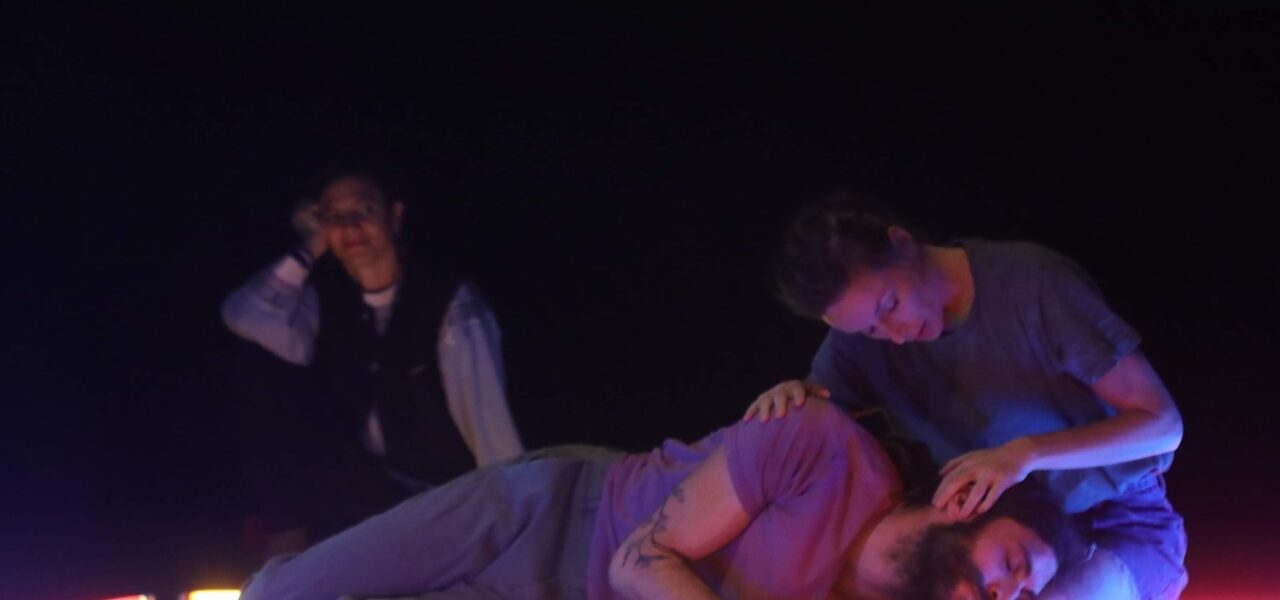Performing Through War by Ori Lenkinski

*originally published in Hebrew on the Parental Choreography column on Haaretz
*In Photo: Tomer Giat and Ori Lenkinski in Etai’s Castle by Rachel Erdos. Photo by Natasha Shaknes
On the day of the hostage release, I traveled to the Sha’ar Hanegev Dance School to perform a children’s dance theater piece. The show was part of the Israeli Choreographers Association’s Moving Together project, which brings performances and workshops to communities affected and displaced by the current war.
To prepare for the performance, our team with a social worker to discuss how to be certain the content of our show would not trigger our audience. The content of the performance deals with the concept of home, which for many of the families in the area, is incredibly charged.
During the drive down from Tel Aviv, we drove alongside the northern border of Gaza. Shai Haramati, the director of the dance school, pointed out the intersections where Hamas terrorists gunned down civilians, residents of the many towns nearby. There were enormous yellow flags lining the roads and large, printed signs of hostages still being held mere kilometers away.
For the past fifteen months, I have imagined Gaza endlessly, but being so close to the border made the twisted reality we are enduring seem all the more insane. As we drove, Red Cross vehicles approached the transfer point, where they would collect Romi, Emily and Doron from Hamas militants.
Though sixty-four people had signed up to attend the performance only twenty showed up. The rest were, I imagine, glued to their televisions.
The show took place at 5 PM, exactly as the three women were handed over to Israeli forces. Instead of watching this event that we have all longed for unfold, we turned on our lights and plunged into an hour of singing, dancing and imagination. One of the families that came consisted of a mother, a six-year-old boy and a baby girl. During the show, I tried not to imagine the year that they’ve had, the fact that the little girl’s entire life has been lived under the threat of war and the type of stress her mother must be under.
Prior to my participation in this show, I had not performed for children, aside from my own, for many years. When I was offered the project, I was hesitant. There is an unfortunate stigma in the dance world that children’s performances are somehow less artistically fulfilling.
However, as experience has taught me over the past four years, the exact opposite is true. To create a successful performance for children requires a type of clarity other shows do not. Children do not lie to you about their enjoyment level, they don’t say, ‘it was interesting’ or ‘that was food for thought’. If they’re into it, you can tell. And if they aren’t, they make sure to let you know. When the show doesn’t work, they wiggle, chat, look for snacks, and, in some cases, simply get up and leave. Performing for children is the purest, most direct and rewarding experience one can have on stage.
The performance in Sha’ar Hanegev was our fifth this month. We recently performed four additional shows in Tel Aviv. In each, we were met with beautiful little people eager to dive into an imaginary world with us. They giggled, yelled out their answers to our questions, copied our movements and sang along to familiar tunes. These reactions are not unusual. Regardless of their location, family background or economic status, children respond in largely the same ways.
Where I have sensed a shift recently was with the parents. At least one parent approached us in tears after each show. They couldn’t explain why but they were moved.
Over the Chanukah break, I took my girls to see Pinocchio at Habima. I found myself similarly emotional throughout the show. Pinocchio, which is beautifully crafted and performed, allowed for an hour in which I didn’t worry about the future or check the onslaught of notifications on my phone. If before the war, going to a show meant taking a much-needed break from the intensity of life, the relief of those moments has been amplified exponentially by the war.
Parenting through a war is nearly impossible. But parenting through this war, in which we watch other parents fight tirelessly to move some invisible political needle so that their children can come home to them, has rocked me to my core.
Over the past many months, I came to the realization that the structures in place to assure our sanity and our safety are faulty at best. At worst they are funneling resources away from our wellbeing to secure power and financial gain. Shortages in teachers and medical professionals is partnered with a steeply rising cost of living, further skewing the give and take of living in Israel towards unbearable. It feels we are hanging off a cliff with few strands of hope to grab onto. If any part of me could live with these facts, I cannot bear them when it comes to my kids. And perhaps because of this sense of abandonment, coming into contact with an artist or company that invested time, thought, money and energy into creating a special experience for my children sparks new hope.
Though I could not have imagined it when we embarked upon the project, performing for children at this time in this country is one of the great privileges of my life. And looking around the studio in Sha’ar Hanegev, I was grateful for that hour away from the world, and for the opportunity to dance for a handful of hopeful small faces.
